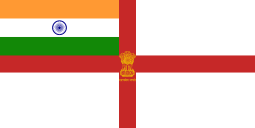INS Vindhyagiri
INS Vindhyagiri was a Nilgiri-class frigate of the Indian Navy. Vindhyagiri was commissioned on 8 July 1981. Having served in the Indian Navy for nearly thirty years, the vessel sank a few hours after colliding with a merchant vessel on 30 January 2011. It was subsequently salvaged and then decommissioned on 11 June 2012. It served for 31 years in the navy and in its prime served as the flagship of the Western Naval Command. It was decommissioned a year earlier than envisaged due to the collision.
| History | |
|---|---|
| Name: | INS Vindhyagiri |
| Commissioned: | 8 July 1981 |
| Decommissioned: | 11 June 2012 |
| Identification: | Pennant number: F42 |
| Honours and awards: | Served as flagship of Western Fleet |
| Fate: | Capsized after collision |
| Status: | Salvaged and decommissioned |
| General characteristics | |
| Class and type: | Nilgiri-class frigate |
| Displacement: |
|
| Length: | 113 m (371 ft) |
| Beam: | 13 m (43 ft) |
| Draught: | 4.3 m (14 ft) |
| Propulsion: |
|
| Speed: | 28 kn (52 km/h; 32 mph) |
| Range: | 4,000 nmi (7,400 km; 4,600 mi) @ 12 kn (22 km/h; 14 mph) |
| Complement: | 267 (incl 17 officers)[1] |
| Sensors and processing systems: |
|
| Armament: |
|
| Aircraft carried: | 1 Westland Sea King or HAL Chetak |
Coup attempts
In 1986, there was a series of coup attempts against President René led by the Seychelles Minister of Defence, Ogilvyi Berlouis. This included a plot in June 1986, codenamed Operation Distant Lash, which involved some 30 mercenaries and 350 Seychellois.[2]
When New Delhi was informed of an impending coup by intelligence sources, Prime Minister Rajiv Gandhi personally contacted the Indian Chief of Naval Staff, Admiral Radhakrishna Hariram Tahiliani, with a verbal request to provide assistance to René. Coincidentally, the Indian Navy had already dispatched the Vindhyagiri on a scheduled visit to Seychelles. It was decided that on arrival Vindhyagiri would report an engineering defect requiring an extended stay in Port Victoria. A senior Indian naval officer was then sent to the Seychelles on a commercial airline to command the operation and an "engineering" team of 20 sailors trained in weapons was readied for dispatch to Port Victoria. The extended presence of the Vindhyagiri in Port Victoria averted the planned coup.
January 2011 collision
On 30 January 2011, Vindhyagiri collided with the Cyprus-flagged merchant ship MV Nordlake near Sunk Rock lighthouse at the entrance of Mumbai harbour at 3:30 pm. It was reported that several civilians, including family members of the crew, were on board at the time of the incident. No casualties were reported.[3] The collision caused major damage in the hull of the ship, affecting the boiler room and motor room. The collision also caused a major fire to break out, which took more than 15 hours to control.
On 31 January 2011, Vindhyagiri settled on the sea bed at Berth No 5 the Mumbai Naval Dockyard due to flooding in some of its compartments from the collision and fire.[4]
Chief Public Relations Officer (Defence) Captain M. Nambiar told The Hindu newspaper that: "The place where the ship is berthed hardly has enough water. It is just seven metres deep. The ship touched the bottom because of flooding in some compartments. She is on the sea bed. Of course, she can be recovered."[5]
After spending close to five months on the seabed, the ship was raised by the Titan Salvage company, with the assistance of the naval architect firm Salvage Master and a 24-hour diving crew. The procedure started with patches to the hull, followed by using multiple pumps to remove the water from inside the wreck, all while a giant floating crane lifted the wreck and kept it stable while the salvage crew performed their work.[6]
Decommissioning
On 8 May 2012, the Bombay High Court granted permission to the Indian Navy to decommission and destroy the ship after one ammunition chamber could not be emptied. It was due to be expended as a target.[7] The ship was decommissioned subsequently on 11 June 2012.
References
- "Surface Ships". Indian Navy. Archived from the original on 15 February 2008. Retrieved 1 February 2011.
- David Hebditch and Ken Connor, How to Stage a Military Coup: From Planning to Execution (London: Greenhill, 2005), p.155.
- "INS Vindhyagiri goes down". Hindustan Times. Retrieved 1 February 2011.
- Naik, Yogesh (31 January 2011). "Navy warship INS Vindhyagiri capsizes". The Times of India. Retrieved 28 May 2013.
- Deshpande, Vinaya (31 January 2011). "States / Other States: INS Vindhyagiri lists, touches sea bed due to flooding". The Hindu. Chennai, India. Retrieved 1 February 2011.
- Iyer, Kavitha (22 June 2011). "INS Vindhyagiri rises from sea". The Indian Express. Retrieved 22 November 2012.
- "INS Vindhyagiri, stuck with ammunition, to be destroyed; court informed of accord". The Hindu. 9 May 2012. Retrieved 9 May 2012.
